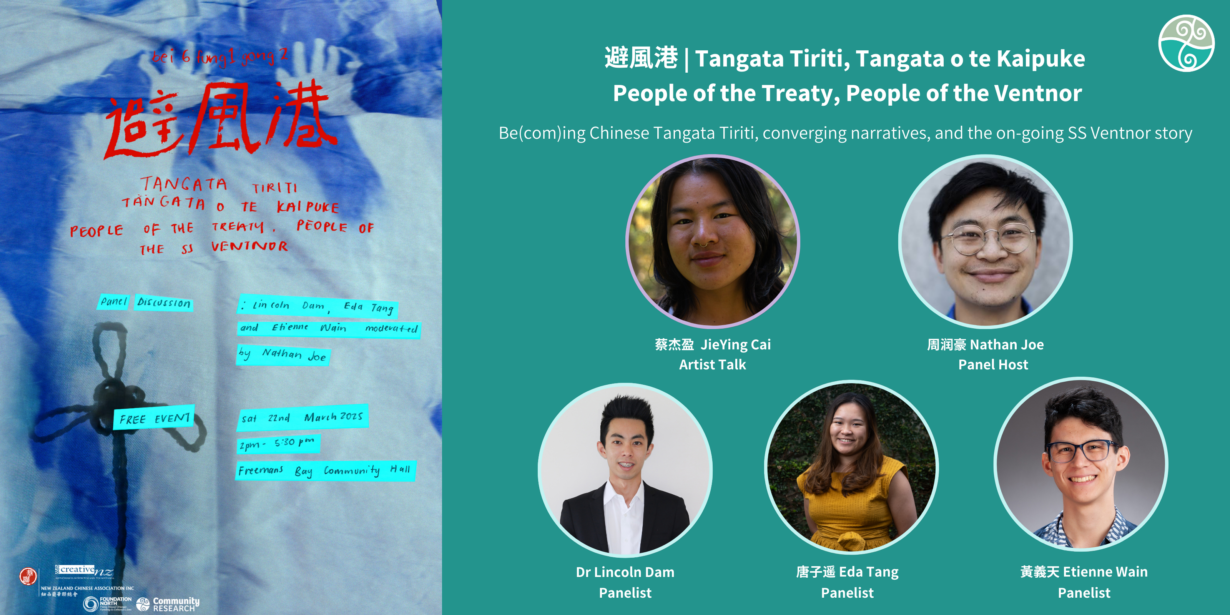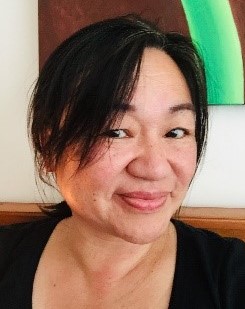Be(com)ing Chinese Tangata Tiriti, converging narratives, and the on-going SS Ventnor story
Presenters include: JieYing Cai, Etienne Wain, Lincoln Dam, Eda Tang, Nathan Joe
Community Research were pleased to support the livestream of ‘避風港 | Tangata Tiriti, Tangata o te Kaipuke | People of the Treaty, People of the Ventnor‘ which was held at Freeman’s Bay Community Hall in Tāmaki Makarau on Saturday 22 March.
With special thanks to the New Zealand Chinese Association and Foundation North Asian Artists’ Fund for funding and supporting Ko wai ngā mokopuna? 汀線, the project comprising 雙土海葬 DOUBLE BURIAL and 避風港 | Tangata Tiriti, Tangata o te Kaipuke | People of the Treaty, People of the Ventnor and to Ngāti Whātua Ōrākei for their manaaki and support in making this event possible.
The Artists Talk by JieYing Cai who has recently curated the exhibition 雙土海葬 DOUBLE BURIAL, explores the unique relationship between Māori and Chinese through shared rituals around death, burial and afterlife. This exhibition ran from 2-28 February at the Shutter Room Gallery in Whangārei. JieYing will be telling us more about this exhibition and the artworks presented.
You can watch JieYing’s ‘Hokinga Mahara Pāruru’ video on the seeds of the Double Burial Exhibition here.
The Panel kōrero presents reflections about the exhibition, be(com)ing Chinese Tangata Tiriti, whanaungatanga, shared history, and the poignant intergenerational legacy of the SS Ventnor. This session was moderated by award-winning playwright and performance poet, Nathan Joe, and features young Chinese New Zealander academics and creatives: Etienne Wain, Dr Lincoln Dam, Eda Tang.
Context
The SS Ventnor was chartered by the Chinese New Zealand community in 1902 to return those who had died in New Zealand to their families in China. The ship had only just left Wellington when it struck a reef off the Taranaki. On 28 October 1902 it sank off the coast of the Hokianga. Thirteen crew and passengers died and the remains of 499 men were lost.
Over the following months, some of these remains (kōiwi) floated to shore where they were cared for by the different iwi who lived along the coast. It was not until 2007 that Chinese descendants became aware that their ancestral bones had been cared for. Since then, Chinese and Māori descendants have built strong relationships at a people-to-people level and between the New Zealand Chinese Association, Te Roroa Whatu Ora and Manawhenua Trust Board, Mātihetihe Marae Committee (Te Rarawa) and Te Hua o te Kawariki Trust.
In 2024 the New Zealand Chinese Association led a group of young Chinese New Zealanders to the Hokianga and to Waitangi celebrations to pay respects, learn, strengthen identity and build relationships. The haerenga (journey) was called Pāruru or place of shelter, in recognition of what was gifted to the Ventnor ancestors. This panel discussion and the preceding exhibition is a result of that haerenga and the discussions and connections made during that journey.
Presenters
蔡杰盈 JieYing Cai is a Chinese-born artist with ancestors from Jiangxi, Ganzhou. They are a multimedia artist who works with photography and textiles. Their practice explores identity, custom and tradition. A recent artist residency in Hokianga guided them to their most recent work, 雙土海葬 DOUBLE BURIAL. JieYing was an attendee of Pāruru 2024 and is currently studying Pūtaketanga o te reo at Te Wānanga o Aotearoa.
周润豪 Nathan Joe is an award-winning playwright and performance poet based in Tāmaki Makaurau. He was the recipient of the 2021 Bruce Mason Playwriting Award and the 2020 National Poetry Slam Champion. His best known work, Scenes from a Yellow Peril, premiered at the ASB Waterfront Theatre in 2022. Most recently, he presented A Short History of Asian New Zealand Theatre, which blended theatre history with performance essay.
黃義天 Etienne Wain is Peranakan Malaysian-Chinese (Hakka, Hokkien, Hainanese) and Pākehā. Etienne is a final-year Law PhD candidate at Te Herenga Waka – Victoria University of Wellington, writing about what it means to be Tangata Tiriti. Their research includes a case study on Chinese Tangata Tiriti, focused around the story of the SS Ventnor. They also express themselves through poetry, music and embroidery, including work featured in 雙土海葬 DOUBLE BURIAL.
Dr Lincoln Dam is a lecturer in Te Kura Mātauranga, the School of Education, at Auckland University of Technology (AUT). His work explores Asian-Māori and Asian-Te Tiriti relations, biculturalism and multiculturalism in Aotearoa-New Zealand, and multicultural education. Lincoln was born in Aotearoa-New Zealand to a Thai-Chinese mother and a Chinese-Cambodian-refugee father.
唐子遥 Eda Tang is a second-generation Chinese New Zealander descending from Guangzhou, China. She is a writer and journalist whose work has featured in Stuff, Ensemble, The Spinoff and The D*List. Passionate about language revitalisation, she is a student and teacher of te reo Māori and is recording bilingual oral histories from Cantonese elders across Aotearoa.
Noho Tahi Project | 和平共處
Launched on Wednesday 12 March in hard copy format, Noho Tahi | 和平共處 is a collection of writing and art by Chinese and Māori creatives, exploring what it means to be Chinese in Aotearoa and how Chinese and Māori communities might co-exist together and work towards mutual flourishing. The publication features multiple pieces on the Ventnor story and what it might mean to be Chinese Tangata Tiriti.
We have a limited number of copies available at the moment, so if you are interested in copies from our next print run (May/June), please email nohotahiproject@gmail.com with your name, email, location and desired number of copies. We can also email you the .pdf version if you desire. Please also email us if you are interested in keeping up to date with future Noho Tahi initiatives, including plans for an interactive online version.
Cost-wise, we are operating on a koha basis at the moment. Koha can be provided to our project account:
38-9001-0567990-31
Etienne Wain
Each copy costs around $10 to print (not including volunteer labour), and any amount per copy beyond that will contribute towards future printing costs.
For more details about the Noho Tahi publication and the Dan and Una Chan and Laywood and Joyce Chan Residency at Wai-te-ata Press, our generous funders: https://www.wgtn.ac.nz/wtapress/chinese-scholars-studio/the-dan-and-una-chan-and-laywood-and-joyce-chan-residency-at-wai-te-ata-press


